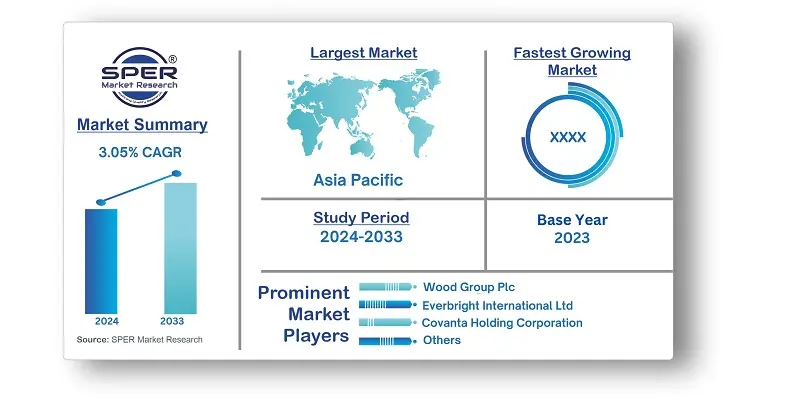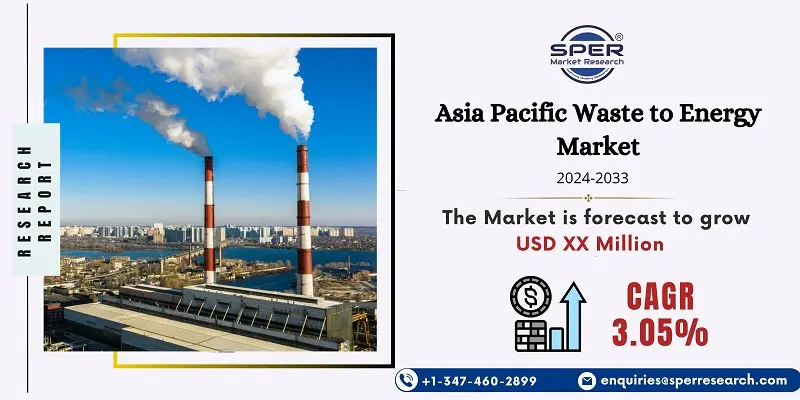
Asia Pacific Waste to Energy Market Growth, Trends, Size, Share, Revenue and Future Outlook
Asia Pacific Waste to Energy Market Size- By Technology, By Type of Waste, By Application- Regional Outlook, Competitive Strategies and Segment Forecast to 2033
| Published: Jul-2024 | Report ID: POAE2464 | Pages: 1 - 152 | Formats*: |
| Category : Power & Energy | |||
- Vishnu Surya Projects and Infra Limited (VSIL), a large Indian building and infrastructure corporation, announced plans to enter the waste management industry in March 2024. They accomplished this through strategic alliances known as Memorandums of Understanding (MoUs) with Hitachi Zosen India Private Limited and AG Enviro Infra Projects Private Limited.
- A memorandum of understanding was signed in March 2024 by EverWind Fuels and Eastward Energy to advance the use of sustainable energy by enhancing Nova Scotia's green hydrogen industry.
- Blue Planet Environmental Solutions acquired a portion of Mahindra Waste to Energy Solutions Limited (MWTESL), a business under the Mahindra Group, in February 2024. In order to further activities related to sustainability and the circular economy, this link is crucial.


| Report Metric | Details |
| Market size available for years | 2020-2033 |
| Base year considered | 2023 |
| Forecast period | 2024-2033 |
| Segments covered | By Technology, By Type of Waste, By Application |
| Regions covered | China, Japan, India, South Korea, Australia, Indonesia, Others |
| Companies Covered | Wood Group Plc, Babcock & Wilcox Enterprises Inc, C&G Environmental Protection Holdings Ltd, Everbright International Ltd, Covanta Holding Corporation, Plantec Asia Pacific Pte Ltd, Hitachi Zosen Corporation, Keppel Seghers, Suez Environnement Company, Mitsubishi Heavy Industries, Ltd. |
- Government Bodies and Regulatory Authorities
- Waste Management Companies
- Energy Companies
- Investors and Financial Institutions
- Technology Providers
- Industrial and Commercial Establishments
- Environmental and Non-Governmental Organizations (NGOs)
- Research and Academic Institutions
- Residential Consumers
| By Technology: | |
| By Type of Waste: | |
| By Application: |
- Asia Pacific Waste to Energy Market Size (FY’2024-FY’2033)
- Overview of Asia Pacific Waste to Energy Market
- Segmentation of Asia Pacific Waste to Energy Market By Technology (Thermal, Incineration, Pyrolysis, Gasification, Biological, Physical)
- Segmentation of Asia Pacific Waste to Energy Market By Type of Waste (Municipal Waste, Agricultural Waste, Industrial Waste, Others)
- Segmentation of Asia Pacific Waste to Energy Market By Application (Electricity, Heat, Combined Heat and Power, Transport fuels, Others)
- Statistical Snap of Asia Pacific Waste to Energy Market
- Expansion Analysis of Asia Pacific Waste to Energy Market
- Problems and Obstacles in Asia Pacific Waste to Energy Market
- Competitive Landscape in the Asia Pacific Waste to Energy Market
- Impact of COVID-19 and Demonetization on Asia Pacific Waste to Energy Market
- Details on Current Investment in Asia Pacific Waste to Energy Market
- Competitive Analysis of Asia Pacific Waste to Energy Market
- Prominent Players in the Asia Pacific Waste to Energy Market
- SWOT Analysis of Asia Pacific Waste to Energy Market
- Asia Pacific Waste to Energy Market Future Outlook and Projections (FY’2024-FY’2033)
- Recommendations from Analyst
1.1. Scope of the report1.2. Market segment analysis
2.1. Research data source2.1.1. Secondary Data2.1.2. Primary Data2.1.3. SPER’s internal database2.1.4. Premium insight from KOL’s2.2. Market size estimation2.2.1. Top-down and Bottom-up approach2.3. Data triangulation
4.1. Driver, Restraint, Opportunity and Challenges analysis
4.1.1. Drivers4.1.2. Restraints4.1.3. Opportunities4.1.4. Challenges
4.2. COVID-19 Impacts of the Asia Pacific Waste to Energy Market
5.1. SWOT Analysis5.1.1. Strengths5.1.2. Weaknesses5.1.3. Opportunities5.1.4. Threats5.2. PESTEL Analysis5.2.1. Political Landscape5.2.2. Economic Landscape5.2.3. Social Landscape5.2.4. Technological Landscape5.2.5. Environmental Landscape5.2.6. Legal Landscape5.3. PORTER’s Five Forces5.3.1. Bargaining power of suppliers5.3.2. Bargaining power of buyers5.3.3. Threat of Substitute5.3.4. Threat of new entrant5.3.5. Competitive rivalry5.4. Heat Map Analysis
6.1. Asia Pacific Waste to Energy Market Manufacturing Base Distribution, Sales Area, Product Type6.2. Mergers & Acquisitions, Partnerships, Product Launch, and Collaboration in Asia Pacific Waste to Energy Market
7.1. Asia Pacific Waste to Energy Market Size, Share and Forecast, By Technology, 2020-20267.2. Asia Pacific Waste to Energy Market Size, Share and Forecast, By Technology, 2027-20337.3. Thermal7.4. Incineration7.5. Pyrolysis7.6. Gasification7.7. Biological7.8. Physical
8.1. Asia Pacific Waste to Energy Market Size, Share and Forecast, By Type of Waste, 2020-20268.2. Asia Pacific Waste to Energy Market Size, Share and Forecast, By Type of Waste, 2027-20338.3. Municipal Waste8.4. Agricultural Waste8.5. Industrial Waste8.6. Others
9.1. Asia Pacific Waste to Energy Market Size, Share and Forecast, By Application, 2020-20269.2. Asia Pacific Waste to Energy Market Size, Share and Forecast, By Application, 2027-20339.3. Electricity9.4. Heat9.5. Combined Heat and Power (CHP)9.6. Transport fuels9.7. Others
10.1. Asia Pacific Waste to Energy Market Size and Market Share
11.1. Asia Pacific Waste to Energy Market Size and Market Share By Region (2020-2026)11.2. Asia Pacific Waste to Energy Market Size and Market Share By Region (2027-2033)11.3. China11.4. Japan11.5. India11.6. South Korea11.7. Australia11.8. Indonesia11.9. Others
12.1. Wood Group Plc12.1.1. Company details12.1.2. Financial outlook12.1.3. Product summary12.1.4. Recent developments12.2. Babcock & Wilcox Enterprises Inc12.2.1. Company details12.2.2. Financial outlook12.2.3. Product summary12.2.4. Recent developments12.3. C&G Environmental Protection Holdings Ltd12.3.1. Company details12.3.2. Financial outlook12.3.3. Product summary12.3.4. Recent developments12.4. Everbright International Ltd12.4.1. Company details12.4.2. Financial outlook12.4.3. Product summary12.4.4. Recent developments12.5. Covanta Holding Corporation12.5.1. Company details12.5.2. Financial outlook12.5.3. Product summary12.5.4. Recent developments12.6. Plantec Asia Pacific Pte Ltd12.6.1. Company details12.6.2. Financial outlook12.6.3. Product summary12.6.4. Recent developments12.7. Hitachi Zosen Corporation12.7.1. Company details12.7.2. Financial outlook12.7.3. Product summary12.7.4. Recent developments12.8. Keppel Seghers12.8.1. Company details12.8.2. Financial outlook12.8.3. Product summary12.8.4. Recent developments12.9. Suez Environnement Company12.9.1. Company details12.9.2. Financial outlook12.9.3. Product summary12.9.4. Recent developments12.10. Mitsubishi Heavy Industries, Ltd12.10.1. Company details12.10.2. Financial outlook12.10.3. Product summary12.10.4. Recent developments
12.11. Others
SPER Market Research’s methodology uses great emphasis on primary research to ensure that the market intelligence insights are up to date, reliable and accurate. Primary interviews are done with players involved in each phase of a supply chain to analyze the market forecasting. The secondary research method is used to help you fully understand how the future markets and the spending patterns look likes.
The report is based on in-depth qualitative and quantitative analysis of the Product Market. The quantitative analysis involves the application of various projection and sampling techniques. The qualitative analysis involves primary interviews, surveys, and vendor briefings. The data gathered as a result of these processes are validated through experts opinion. Our research methodology entails an ideal mixture of primary and secondary initiatives.



Frequently Asked Questions About This Report
PLACE AN ORDER
Year End Discount
Sample Report
Pre-Purchase Inquiry
NEED CUSTOMIZATION?
Request CustomizationCALL OR EMAIL US
100% Secure Payment






Related Reports
Our Global Clients
Our data-driven insights have influenced the strategy of 200+ reputed companies across the globe.




















